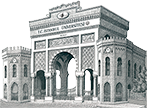"Recataloging of Arabic Manuscripts in Istanbul University Rare Works Library" Project was presented
The presentation of the Project for the Recataloging of Arabic Manuscripts in Istanbul University Rare Manuscripts Library was held at Istanbul University Rare Manuscripts Library on June 14, 2023.
The program was held with the participation of Prof. Dr. Mahmut Ak, Rector of IU, Metin Küçük, Secretary General of IU, Prof. Dr. Mürteza Bedir, President of ISAM and Project Coordinator, Prof. Dr. Ahmet Hamdi Furat, Director of IU Institute of Islamic Studies, Prof. Dr. Ferruh Özpilavcı, President of the Manuscripts Institution of Turkey, Prof. Dr. Cengiz Tomar, Ms. Gülhan Kavakçı, one of the former librarians of IU Institute of Islamic Studies, academicians and guests.


Istanbul University, The Place Where Higher Education Culture in Turkey Began
Finally, Prof. Dr. Mahmut Ak delivered his speech. Prof. Dr. Ak said, "Istanbul University is the home of knowledge and wisdom where the higher education culture in Turkey began. Whatever we know in the name of higher education in Turkey, the foundation of all of these was laid in this institution. Afterwards, their qualification was also provided by the staff of this institution. It is no coincidence that such a project is conducted here."
Stating that there are six national libraries in Turkey, Prof. Dr. Ak said, "One of these six libraries is the Istanbul University Library. On this occasion, there are currently 2,150,000 registered works and newspaper collections. There are also maps, plates and other kinds of cultural heritage here. Of course, it is also important that all of these are in this building." He thanked everyone who contributed and wished the continuity of the project.
Then the project researchers made a short presentation one by one.
Assoc. Prof. Adem Arıkan made a presentation on who read and studied these works in the Hanafi-Maturidi circle based on the three separate ijazats of Mustafa Aşir Efendi (1729-1804) at the beginning of Abu Hanifa's al-Fiqh al-Akbar, al-Fiqh al-Absat and al-Wasiyya, which were all found together in a majmua.
Research Assistant Şaban Kütük presented Burhān al-Dīn al-Nasafī's (d. 687/1289) work on the science of jadal, al-Qawānīn al-qātia wa al-barāhīn al-sātia. Moreover, he pointed out that this is the only known copy and it is in the Rare Manuscript Library of Istanbul University. He stated that the copy of the aforementioned work was copied fourteen years before the author's death.
Research Assistant Musa Sancak shared the story of a lost tafsir that lasted over a century. The author, Abdurrahman b. Muhammad Salih Salih al-Ayyân (d. 1323/1906), wrote an 8-volume tafsir titled Juhd al-muqill alā al-kalām allāzī lā yumill, which was first given to his eldest son by the author. The eldest son, Sheikh Muhammad al-Ayyān, was invited to Istanbul by the Rufā'ī sheikh Abū al-Huda al-Sayyādī, who was known to be close to Abdulhamid II at the time, and brought the tafsīr with him to Istanbul. Fearing for his life during the attempted coup d'état against Abdülhamid II in 1906, Shaykh Ayyân gave the work to a man named Hulûsî (Hâlis) Efendi. Hulûsî Efendi is thought to be the collection where the work was found. His descendants have been informed about this work, which has been sought by them for many years. The value of the work can be understood from the commentaries written on it by Aleppo scholars of the period. This work, which is still on the library shelves, awaits the work of researchers.
Research Assistant Mustafa Tanrıver introduced a copy of Sharḥ Vikāyat al-rivāya fī masāʾil al-Hidāye, which was written by al-Sadr al-Sharī'at al-Thānī to Vikāyat al-rivāya fī masāʾil al-Hidāye and considered among the mutūn al-arbaʿa in the Hanafi madhhab. In the last part of the work, he stated the difficulties encountered by the mustansikh while comparing the copies of the work and that the records containing important information in terms of the history of science and culture, in which he writes the reliable books of the Hanafi madhhab, increase the value of the work even more.
Yunus Emre Karadağ introduced the autograph manuscript of Hariri's (d. 516/1122) famous work al-Maqāmat. In his presentation, he explained the copy's zahriyya, hamishs and the records at the end. The participants discussed the possibility of a facsimile edition of this copy.
Research Assistant Ahmet Faruk Şener introduced Sipahizade Mehmed b. Ali al-Bursevi's (d. 997/1589) Selem and Vekalet Risalas, which have not been identified in the literature. He drew attention to the fact that these treatises were written in response to Sultan Selim II's order to conduct an examination when the Hidaya reading circle was completed.
Research Assistant İsrafil Şen introduced the original copy of Ibn Karatekin's (d. 648/1251) Subul al-rashad fî fazl al-jihad dated 647/1249. Şen concluded his presentation by emphasizing that the work is not well known in the literature and that he could not find another copy of it.
Research Assistant Hasan Korkmaz introduced the most ancient manuscript of the Rare Works Library, the Arabic language scholar and linguist Ishaq b. Ibrahim al-Farabi's (d. 350/961 [?]) work titled Dîwân al-adab. He stated that the work was inscribed in 372/982 and is a copy of approximately 1041 years old.
Research Assistant Enes Yılmaz introduced the most ancient copy of Abū al-Muʾīn al-Nasafī's (d. 508/1115) al-Tamhīd li-qavaidi al-tawhid, which developed the Sunnī theological school founded by Imam Maturidī. Yılmaz explained the records at the beginning and end of the manuscript one by one, and said that this copy was inscribed in 534/1139, 26 years after the author's death.
Research Assistant Faruk Mergen introduced the commentary of al-Aqidah of Abu Muhammad Yunus b. Yusuf (d. 619/1222), the founder of the Shaybaniyya branch of the Sadiyya sect, by Sayyid Ali al-Wasfî (d. 1299/1882). He said that this work is not covered in the literature and that it is an important work that needs to be analyzed.
This news article has been created by expanding the news published on Istanbul University website. For that news:
Arapça Yazma Eserlerin Yeniden Kataloglanması Projesi Tanıtımı Gerçekleştirildi (istanbul.edu.tr)













